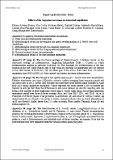Por favor, use este identificador para citar o enlazar a este item:
http://hdl.handle.net/10261/224084COMPARTIR / EXPORTAR:
 SHARE SHARE
 CORE
BASE CORE
BASE
|
|
| Visualizar otros formatos: MARC | Dublin Core | RDF | ORE | MODS | METS | DIDL | DATACITE | |

| Título: | Effects of the Argentine ant venom on terrestrial amphibians |
Autor: | Álvarez-Blanco, Paloma; Cerdá, Xim CSIC ORCID ; Hefetz, Abraham; Boulay, Raphaël; Bertó-Morán, Alejandro CSIC; Díaz-Paniagua, Carmen CSIC ORCID; Lenoir, Alain; Billen, J.; Liedtke, H. Christoph; Chauan, K.R.; Bhagavathy, Ganga; Angulo, Elena CSIC ORCID | Fecha de publicación: | 2020 | Editor: | Blackwell Publishing | Citación: | Conservation Biology (2020) | Resumen: | Invasive species have major impacts on biodiversity and are one of the primary causes of amphibian decline and extinction. Unlike other top ant invaders that negatively affect larger fauna via chemical defensive compounds, the Argentine ant (Linepithema humile) does not have a functional sting. Nonetheless, it deploys defensive compounds against competitors and adversaries. We estimated levels of ant aggression toward 3 native terrestrial amphibians by challenging juveniles in field ant trails and in lab ant foraging arenas. We measured the composition and quantities of toxin in L. humile by analyzing pygidial glands and whole-body contents. We examined the mechanisms of toxicity in juvenile amphibians by quantifying the toxin in amphibian tissues, searching for histological damages, and calculating toxic doses for each amphibian species. To determine the potential scope of the threat to amphibians, we used global databases to estimate the number, ranges, and conservation status of terrestrial amphibian species with ranges that overlap those of L. humile. Juvenile amphibians co-occurring spatially and temporally with L. humile die when they encounter L. humile on an ant trail. In the lab, when a juvenile amphibian came in contact with L. humile the ants reacted quickly to spray pygidial-gland venom onto the juveniles. Iridomyrmecin was the toxic compound in the spray. Following absorption, it accumulated in brain, kidney, and liver tissue. Toxic dose for amphibian was species dependent. Worldwide, an estimated 817 terrestrial amphibian species overlap in range with L. humile, and 6.2% of them are classified as threatened. Our findings highlight the high potential of L. humile venom to negatively affect amphibian juveniles and provide a basis for exploring the largely overlooked impacts this ant has in its wide invasive range. | Versión del editor: | http://dx.doi.org/10.1111/cobi.13604 | URI: | http://hdl.handle.net/10261/224084 | DOI: | 10.20350/digitalCSIC/8602 | Identificadores: | doi: 10.1111/cobi.13604 issn: 1523-1739 |
| Aparece en las colecciones: | (EBD) Artículos |
Ficheros en este ítem:
| Fichero | Descripción | Tamaño | Formato | |
|---|---|---|---|---|
| 19-844.R2_Proof_h1.pdf | 2,32 MB | Adobe PDF |  Visualizar/Abrir | |
| SupportingInformationS1_S4.pdf | 5,11 MB | Adobe PDF |  Visualizar/Abrir |
CORE Recommender
Page view(s)
134
checked on 27-abr-2024
Download(s)
343
checked on 27-abr-2024
Google ScholarTM
Check
Altmetric
Altmetric
NOTA: Los ítems de Digital.CSIC están protegidos por copyright, con todos los derechos reservados, a menos que se indique lo contrario.
